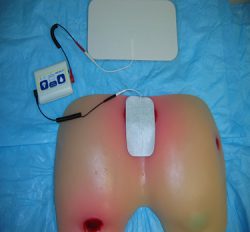Here are practice enablers, decision support tools, useful forms, and research articles to inform clinicians using Estim to treat people with chronic wounds.
Harnessing electrical, light, and sound energy to improve wound healing outcomes.
Here are practice enablers, decision support tools, useful forms, and research articles to inform clinicians using Estim to treat people with chronic wounds.
Electrical stimulation therapy (Estim), involves the delivery of electrical current directly to the wound and/or surrounding skin at a level that would normally produce pins needles sensation. Estim is applied to the wound bed using a specialized type of current and sterile electrodes via a small, battery-operated, portable device. Estim should be applied by a regulated health care provider including Physical Therapists or Nurses who have taken advanced training in the safe and effective use of Estim. This Estim provider will design a protocol that is customized to meet the patients’ and caregivers wishes and schedules. Once set up, Estim remains in place for at least 1 hour. Treatments should be administered no fewer than 3 times per week and continue until the wound has closed completely.
There is strong clinical research evidence that Estim can accelerate closure of open skin wounds that are delayed in healing because of a number of co-existing medical conditions such as pressure injuries/u

lcers, diabetic foot ulcers, and leg wounds due to peripheral vascular disease (venous, arterial). Estim works by replacing the electrical current that naturally speeds healing, it promotes local circulation and delivery of oxygen and nutrients to the area, it keeps the wound clean and freeof bacteria, and facilitates deposition of new tissue to fill the wound and promotes recovering of the wound with new skin. An additional benefit of Estim, is that nerve stimulation by Estim can reduce pain in the wound region. Estim is often used in other countries to assist healing of many types of chronic wounds and its benefits are beginning to be known here in Canada.
Step by step processes of Estim application techniques are available in downloadable pdf documents.
Narrated demonstrations of how to apply Estim using different electrodes applied in (monopolar) and around (bipolar) the wound.
One of the greatest challenges facing clinicians introducing Estim into wound care practices, is identifying what client and which wound are most likely to respond to Esitm and knowing when the best time to intervene.
INDICATIONS include a list of the types of wound etiology shown to respond to Estim.
CONTRAINDICATIONS: Medical conditions that increase the likelihood of an adverse reaction to Estim is listed. People with conditions listed as Contraindications should avoid using Estim. People with conditions listed as PRECAUTIONS can receive Estim, however, in these circumstances Estim should be applied by an experienced Estim provider who knows what to watch for and is able to provide closer monitoring.